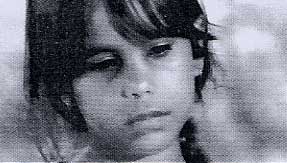ABORIGINE
VISUAL MEMORY
New
research suggests that one part of an aborigine’s brain
is 25 per cent bigger than a European’s – but the
academic community refuses to take it seriously, for fear of
being branded ‘racist’.
Sherilee
is an eight year old who lives in Australia. She seems just
like any other ordinary schoolgirl of her age, but she could
help to resolve one of the most controversial topics in science:
the relationship between genes and intelligence.

The
question of how much of our brain power is fixed by what we
inherit form our parents, and how much is a product of upbringing
and education, is one that appears to fascinate and frighten
everyone – scientists included.
It
is not just the American constitution that is framed around
the conviction hat we are all created equal. Practically the
whole of contemporary politics is based on the idea that the
differences betweenindividuals are not fixed at birth.
The
suggestion that there are inherent differences, not just between
individuals, but between races, is even less acceptable. There
is now evidence, however, that one group of people may indeed
have a superior mental capacity, in at least one respect, to
everyone else – and some of it comes form the eight-year
old Sherilee.
Sherilee
has an astonishingly accurate visual memory. She scores 100
per cent on tests designed to measure how much individuals can
remember of what they see. The only clue to the cause of her
remarkable ability is her race: she is an aborigine, and aborigines
have a proven ability to remember the exact location of objects
that far exceeds that of other ethnic groups. They can find
their way across deserts, locate water holes and identify animal
lairs with an uncanny accuracy. They also perform about 50 per
cent better on visual memory tests than, for instance, Caucasians.
What
is the aborigines’ secret? To some evolutionary psychologists,
the answer is relatively straightforward. The aborigines were,
for about 4,000 generations, or 80,000 years, hunter-gatherers
in the deserts of Australia.
That
is enough time for natural selection to have worked on increasing
the accuracy of aborigines’ memory, because if you could
not find your way through the desert, or to the waterhole, you
would starve, and so would your children. In the competition
to stay alive, an accurate memory would – to put it mildly
– have been an advantage.
Are
today’s aborigine children the inheritors of that process?
It has certainly been speculated that their extraordinary visual
memories are the result of genes selected over thousands of
years by evolution.
By
Clive Harper, a professor of pathology in Sydney, may have discovered
evidence that it is more than just a theoretical possibility.
He found that the visual cortex – the part of the brain
used in processing and interpreting visual information –
was about 25 per cent larger in aborigines than in Caucasians.
Aborigines
can find their way across deserts, locate waterholes and identify
animal lairs with an uncanny accuracy
‘The
idea of genetic differences between the different races’
mental abilities has about as bad a pedigree as it is possible
to image’
‘The
whole of contemporary politics is based on the idea that the
differences between individuals are not fixed at birth’
ALASDAIR
PALMER, The Sunday Telegraph
Genetics
and Genealogy Index
Genetics
and Genealogy
|